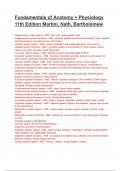Fundamentals of Anatomy + Physiology
11th Edition Martini, Nath, Bartholomew
Integumentary major organs - ANS - skin, hair, sweat glands, nails
\integumentary system functions - ANS - protects against environmental hazards, helps regulate
body temperature, provides sensory information
\skeletal system organs - ANS - bones, cartilages, associated ligaments, bone marrow
\skeletal system functions - ANS - provides support and protection for other tissues, stores
calcium and other minerals, forms blood cells
\muscular system organs - ANS - skeletal muscles and associated tendons
\muscular system functions - ANS - provides movement, provides protection and support for
other tissues, generates heat that maintains body temperature
\nervous system organs - ANS - brain, spinal cord, peripheral nerves, sense organs
\nervous system functions - ANS - directs immediate responses to stimuli, coordinates or
moderates activities of other organ systems, provides and interprets sensory information about
external conditions
\endocrine system organs - ANS - pituitary gland, thyroid gland, pancreas, adrenal glands,
gonads, endocrine tissues in other systems
\Endocrine system functions - ANS - directs long-term changes in the activities of other organ
systems, adjusts metabolic activity and energy use by the body, controls many structural and
functional changes during development
\Cardiovascular system organs - ANS - heart, blood, blood vessels
\Cardiovascular system functions - ANS - distributes blood cells, water, and dissolved materials,
including nutrients, waste products, oxygen and carbon dioxide,
distributes heat and assists in control of body temperature
\Lymphatic system organs - ANS - spleen, thymus, lymphatic vessels, lymph nodes, tonsils
\lymphatic system functions - ANS - defends against infection and disease, returns tissue fluids
to the bloodstream
\Respiratory system organs - ANS - nasal cavities, sinuses, larynx, trachea, bronchi, lungs,
alveoli
\Respiratory system functions - ANS - delivers air to alveoli (sites in lungs where gas exchange
occurs),
provides oxygen to bloodstream,
removes carbon dioxide from bloodstream,
produces sounds for communication
\Digestive system organs - ANS - teeth, tongue, pharynx, esophagus, stomach, small intestine,
large intestine, liver, gallbladder, pancreas
\Digestive system functions - ANS - processes and digests food, absorbs and conserves water,
absorbs nutrients, stores energy reserves
\Urinary system organs - ANS - kidneys, ureters, urinary bladder, urethra





